Recording Permafrost Thaw and Thaw Lake Degradation in Northern Siberia: School Science in Action
Abstract
:1. Introduction
2. Materials and Methods
2.1. Study Area: Geography and Climate
2.2. Study Design, Site Selection, Methodology, and Measurement Tools
- The selection of test sites for the study of thermokarst processes depending on the landscape and geocryological zoning of the territory of the Tazovskiy District of Western Siberia.
- The development of a methodology for assessing temporal changes in the areas of thermokarst lakes using remote sensing data and modern geographic information systems (GIS) and GIS technologies.
- Assessing likely causes of lake degradation, including climate and sandy soil mining.
- The formation of a database for the areas and dynamics of thermokarst lakes based on the results of satellite observations and quantitative analysis of the dynamics of the areas of thermokarst lakes.
- Observations on the impacts of changes in the lake area.
2.2.1. Climate Change
2.2.2. Active Layer Dynamics
2.2.3. Sand Dredging
2.2.4. Statistical Analysis and Presentation
3. Results
3.1. School Science
3.2. Thermokarst Lake Dynamics, Their Causes and Impacts
3.2.1. Potential Causes of Lake Dynamics
- I.
- Climate
- II.
- Active Layer Dynamics
- III.
- Local Anthropological Activities
- IV.
- Ranking the Importance of Factors Potentially Causing Changes in Active Layer Thickness and Lake Area
3.2.2. Impacts of Reduced Lake Areas
4. Discussion
5. Conclusions
Author Contributions
Funding
Institutional Review Board Statement
Data Availability Statement
Acknowledgments
Conflicts of Interest
References
- Shumilova, L.V. Botanical Geography of Siberia; Tomsk State University Press: Tomsk, Russia, 1962. (In Russian) [Google Scholar]
- Biskaborn, B.K.; Smith, S.L.; Noetzli, J.; Matthes, H.; Vieira, G.; Streletskiy, D.A.; Schoeneich, P.; Romanovsky, V.E.; Lewkowicz, A.G.; Abramov, A.; et al. Permafrost is warming at a global scale. Nat. Commun. 2019, 10, 264. [Google Scholar] [CrossRef] [Green Version]
- Callaghan, T.V.; Shaduyko, O.; Kirpotin, S.N.; Gordov, E. Siberian environmental change: Synthesis of recent studies and opportunities for networking. Ambio 2021, 50, 2104–2127. [Google Scholar] [CrossRef]
- Suter, L.J.; Streletskiy, D.A.; Shiklomanov, N.I. Assessment of the cost of climate change impacts on critical infrastructure in the circumpolar Arctic. Polar Geogr. 2019, 42, 267–286. [Google Scholar] [CrossRef]
- Streletskiy, D.A.; Suter, L.J.; Shiklomanov, N.I.; Porfiriev, B.N.; Eliseev, D.O. Assessment of climate change impacts on buildings, structures and infrastructure in the Russian regions on permafrost. Environ. Res. Lett. 2019, 14, 25003. [Google Scholar] [CrossRef]
- Vohland, K.; Land-Zandstra, A.; Ceccaroni, L.; Lemmens, R.; Perelló, J.; Ponti, M.; Samson, R.; Wagenknecht, K. (Eds.) The Science of Citizen Science; Springer: Berlin/Heidelberg, Germany, 2021; 529p. [Google Scholar] [CrossRef]
- Williams, P.; Alessa, L.; Abatzoglou, J.; Kliskey, A.; Witmer, F.; Lee, O.; Trammell, J.; Beaujean, G.; Venema, R. Community-based observing networks and systems in the Arctic: Human perceptions of environmental change and instrument-derived data. Reg. Environ. Change 2017, 18, 547–559. [Google Scholar] [CrossRef]
- Klütsch CF, C.; Aspholm, P.E.; Polikarpova, N.; Veisblium, O.; Bjørn, T.-A.; Wikan, A.; Gonzalez, V.; Hagen, S.B. Studying phenological phenomena in subarctic biomes with international school pupils as citizen scientists. Ecol. Evol. 2021, 11, 3501–3515. [Google Scholar] [CrossRef]
- Alessa, L.; Kliskey, A.; Gamble, J.; Fidel, M.; Beaujean, G.; Gosz, J. The role of indigenous science and local knowledge in integrated observing systems: Moving toward adaptive capacity indices and early warning systems. Sustain. Sci. 2016, 11, 91–102. [Google Scholar] [CrossRef]
- Lavrillier, A.; Gabyshev, S. An Arctic Indigenous Knowledge System of Landscape, Climate, and Human Interactions: Evenki Reindeer Herders and Hunters; Verlag der Kulturstiftung Sibirien: Fürstenberg, Germany, 2017; 201p. [Google Scholar]
- Petrov, A.N.; Vlasova, T. Towards an Arctic Sustainability Monitoring Framework. Sustainability 2021, 13, 4800. [Google Scholar] [CrossRef]
- Hulbert, A.; Hayes, T.; McKinnon, T.; Goforth, C. Caterpillars Count! A Citizen Science Project for Monitoring Foliage Arthropod Abundance and Phenology. Citiz. Sci. Theory Pract. 2019, 4, 1–12. [Google Scholar] [CrossRef] [Green Version]
- Lavrillier, A.; Gabyshev, S. An Indigenous science of the climate change impacts on landscape topography in Siberia. Ambio 2021, 50, 1910–1925. [Google Scholar] [CrossRef]
- Bogdanova, E.; Lobanov, A.; Andronov, S.; Soromotin, A.; Popov, A.; Skalny, A.; Shaduyko, O.; Callaghan, T. V Access to Natural Drinking Water in the Arctic Zone of Western Siberia in a Changing Climate. Water 2022. submitted. [Google Scholar]
- Ismajylov, G.; Fedorov, V. Forecast of the State of Russia’s Freshwater Resources in Connection with Global and Regional Changes. Prir. Environ. Manag. 2013, 1, 60–64, (In Russian with English Abstract). [Google Scholar]
- Golubyatnikov, L.L.; Zarov, E.A.; Kazantsev, V.S.; Filippov, I.V.; Gavrilov, G.O. Analysis of Landscape Structure in the Tundra Zone for Western Siberia Based on Satellite Data. Issled. Zemli Iz Kosm. 2015, 3, 4–14, (In Russian with English Abstract). [Google Scholar] [CrossRef]
- Im, S.T.; Kharuk, V.I. Water mass dynamics in permafrost of central Siberia based on grace gravity data. Geophys. Process. Biosph. 2015, 14, 53–69, (In Russian with English Abstract). [Google Scholar]
- Vonk, J.E.; Tank, S.E.; Bowden, W.B.; Laurion, I.; Vincent, W.F.; Alekseychik, P.; Amyot, M.; Billet, M.F.; Canário, J.; Cory, R.M.; et al. Reviews and syntheses: Effects of permafrost thaw on Arctic aquatic ecosystems. Biogeosciences 2015, 12, 7129–7167. [Google Scholar] [CrossRef] [Green Version]
- Holgerson, M.A.; Raymond, P.A. Large contribution to inland water CO2 and CH4 emissions from very small ponds. Nat. Geosci. Lett. 2016, 9, 222–226. [Google Scholar] [CrossRef]
- Pokrovsky, O.S.; Manasypov, R.M.; Kopysov, S.G.; Krickov, I.V.; Shirokova, L.S.; Loiko, S.V.; Lim, A.G.; Kolesnichenko, L.G.; Vorobyev, S.N.; Kirpotin, S.N. Impact of Permafrost Thaw and Climate Warming on Riverine Export Fluxes of Carbon, Nutrients and Metals in Western Siberia. Water 2020, 12, 1817. [Google Scholar] [CrossRef]
- Karlsson, J.; Serikova, S.; Vorobyev, S.N.; Rocher-Ros, G.; Denfeld, B.; Pokrovsky, O.S. Carbon emission from Western Siberian inland waters. Nat. Commun. 2021, 12, 825. [Google Scholar] [CrossRef]
- Paramonov, E.G.; Rybkina, I.D. Stabilization of Aley river water content by forest stands. Sib. Lesn. Zurnal Sib. J. For. Sci. 2016, 3, 57–66, (In Russian with English Abstract). [Google Scholar] [CrossRef]
- Vassiliev, G.; Djalyabov ALeonovich, I. Analysis of the causes of deformations of engineering structures of gas complex facilities in the permafrost zone (Analiz prichin vozniknoveniya deformatsiy inzhenernykh so oruzheniy ob”yektov gazovogo kompleksa v kriolitozone). Notes Min. Inst. Zap. Gorn. Inst. 2021, 249, 377–385. [Google Scholar] [CrossRef]
- Smith, L.C.; Sheng, Y.; Macdonald, G.M.; Hinzman, L.D. Disappearing Arctic Lakes. Science 2005, 308, 1429. [Google Scholar] [CrossRef] [PubMed] [Green Version]
- Polishchuk, Y.M.; Bryksina, N.A.; Polishchuk, V.Y. Remote analysis of changes in the number of small thermokarst lakes and their distribution with respect to their sizes in the cryolithozone of Western Siberia. Izv. Atmos. Ocean. Phys. 2015, 51, 999–1006. [Google Scholar] [CrossRef]
- Kravtsova, V.I.; Tarasenko, T.V. Investigation of changes in thermokarst lake distribution in West Siberia by multitemporal satellite images. Environ. Dyn. Glob. Clim. Change 2010, 1, 82–87, (In Russian with English Abstract). [Google Scholar]
- Kirpotin, S.N.; Polishchuk Yu, M.; Bryksina, N.A. Thermokarst lakes square dynamics of West Siberian continuous and discontinuous permafrost under impact of global warming. Vestn. Tomsk State Univ. 2008, 311, 185–189, (In Russian with English Abstract). [Google Scholar]
- Loiko, S.; Klimova, N.; Kuzmina, D.; Pokrovsky, O. Lake Drainage in Permafrost Regions Produces Variable Plant Communities of High Biomass and Productivity. Plants 2020, 9, 867. [Google Scholar] [CrossRef]
- Makarenkova, I.Y.; Uvarova, V.I. Changes in the ecological state of lakes used for the development of sand deposits in the Bovanenkovskoye oil and gas condensate field. Environ. Prot. Oil Gas Complex 2017, 3, 22–27. (In Russian) [Google Scholar]
- Brown, J.; Ferrians, O.J.; Heginbottom, J.A.; Melnikov, E.S. Circum-Arctic Map of Permafrost and Ground-Ice Conditions on CD-ROM; 1998, International Permafrost Association on Data Information and Communication (Comp.) Circumpolar Active-Layer Permafrost System, Version 2.0; Parsons, M., Zhang, T., Eds.; National Snow and Ice Data Center/World Data Center for Glaciology: Boulder, CO, USA, 2003. [Google Scholar]
- Kondratieva, K.A.; Afanasenko, V.E.; Gavrilov, A.V.; Dunaeva, E.N.; Zamolotchikova, S.A.; Trush, N.I.; Lisitsyna, O.M.; Trofimov, V.T.; Sverdlova, L.Y.; Syritsyna, M.I.; et al. Geocryological Map of the USSR, Scale 1:2,500,000; Ministerstvo Geologii: Moscow, Russia, 1996; 16p. (In Russian) [Google Scholar]
- Dobrinskiy, L.N. Priroda Yamala/Otv. Red.; UIF Nauka: Ekaterinburg, Russia, 1995; 487p. [Google Scholar]
- Bolshanik, P.V.; Mukhamedyanov, T.I. Transformation on the relief of the areas of development of gas field of the Taz peninsula. Environ. Dyn. Glob. Clim. Change 2019, 10, 16–27, (In Russain with English Abstract). [Google Scholar] [CrossRef]
- Bryksina, N.A.; Kirpotin, S.N. Landscape-space analysis of change of thermokarst lakes areas and numbers in the permafrost zone of West Siberia. Tomsk State Univ. J. Biol. 2012, 4, 185–194, (In Russian with English Abstract). [Google Scholar]
- Romanov, A.N.; Khvostov, I.V.; Pavlov, V.E.; Vinokurov, Y.I. Remote monitoring of wetland areas of Western Siberia using SMOS (ESA) data. Atmos. Ocean. Opt. 2014, 27, 313–316. [Google Scholar] [CrossRef]
- Bryksina, N.A.; Polishchuk, Y.M. Studying the distribution of thermokarst lakes areas in arctic zone of Western Siberia and their dynamics by the ultrahigh resolution satellite images. Bull. Tomsk. Polytech. Univ. Geo Assets Eng. 2016, 327, 13–21, (In Russian with English Abstract). [Google Scholar]
- Polishchuk, Y.M.; Bogdanov, A.N.; Bryksina, N.A.; Polishchuk, V.Y.; Muratov, I.N.; Kupriyanov, M.A.; Baisalyamova, O.A.; Dneprovskaya, V.P. Experience and results of a remote study of lakes in the permafrost zone of Western Siberia from satellite images of various resolutions over a 50-year period. Current Probl. Remote Sens. Earth Space 2017, 14, 42–55, (In Russian with English Abstract). [Google Scholar] [CrossRef]
- Polishchuk, V.Y.; Muratov, I.N.; Kupriyanov, M.A.; Polishchuk, Y.M. Modeling the fields of thermokarst lakes in the permafrost based on the geo–simulation approach and satellite images. Math. Notes NEFU 2020, 27, 101–114, (In Russian with English Abstract). [Google Scholar] [CrossRef]
- Polishchuk, Y.M.; Muratov, I.N.; Polishchuk, V.Y. Remote research of spatiotemporal dynamics of thermokarst lakes fields in Siberian permafrost. In The Arctic: Current Issues and Challenges; Nova Science Publishers: New York, NY, USA, 2020; pp. 208–237. [Google Scholar]
- Bryksina, N.A. Scientific and Methodological Basis for the Application of Remote Sensing Data in Studying the dynamics of the Thermokarst Landscape of the West Siberian Plain. Ph.D. Thesis, Yugra State University, Khanty-Mansiisk, Russia, 2011. (In Russian). [Google Scholar]
- Ivanova, T.N. Thermokarst lakes of permafrost areas. Adv. Curr. Nat. Sci. 2019, 6, 62–66, (In Russian with English Abstract). [Google Scholar]
- Hecker, S.; Haklay, M.E.; Bowser, A.; Makuch, Z.; Vogel, J.; Bonn, A. (Eds.) Citizen Science; UCL Press: London, UK, 2018. [Google Scholar] [CrossRef]
- Wilson, N.J.; Walter, T.M.; Waterhouse, J. Indigenous Knowledge of Hydrologic Change in the Yukon River Basin: A Case Study of Ruby, Alaska. Arctic 2015, 68, 93–106. [Google Scholar] [CrossRef]
- Community Observation Network for Adaptation and Security (CONAS). Available online: http://conas-ak.org/ (accessed on 12 September 2022).
- Saunders, M.E.; Roger, E.; Geary, W.L.; Meredith, F.; Welbourne, D.J.; Bako, A.; Canavan, E.; Herro, F.; Herron, C.; Hung, O.; et al. Citizen science in schools: Engaging students in research. Aust. Ecol. 2018, 43, 635–642. [Google Scholar] [CrossRef] [Green Version]
- World Meteorological Organization (WMO). Technical Regulations, Basic Documents No. 2, Volume I: General Meteorological Standards and Recommended Practices, 2019th ed.; WMO 49; Secretariat of WMO: Geneva, Switzerland, 2019; 71p. [Google Scholar]
- Levene, H. Contributions to Probability and Statistics: Essays in Honor of Harold Hotelling; Olkin, I., Sudhish, G., Wassily, H., Maddow, W., Eds.; Stanford University Press: Redwood City, CA, USA, 1960; pp. 278–292. [Google Scholar]
- Ob-Irtysh Department for Hydrometeorology and Environmental Monitoring. Available online: http://omsk-meteo.ru/index.php/ru/ (accessed on 15 January 2020).
- Soromotin, A.V.; Prikhodko, N.V.; Sizov, O.S.; Dayzel, A.V.; Kudryavtsev, A.A.; Zakirova, M.R. Geoecology of thermokarst lakes of Western Siberia in the zone of influence of an arctic town (a case study of the town of Nadym). Geogr. Bull. 2022, 2, 90–108, (In Russian with English Abstract). [Google Scholar] [CrossRef]
- Myers-Smith, I.H.; Kerby, J.T.; Phoenix, G.K.; Bjerke, J.W.; Epstein, H.E.; Assmann, J.J.; John, C.; Andreu-Hayles, L. Complexity revealed in the greening of the Arctic. Nat. Clim. Change 2020, 10, 106–117. [Google Scholar] [CrossRef] [Green Version]
- Callaghan, T.V.; Cazzolla Gatti, R.; Phoenix, G. The need to understand the stability of arctic vegetation during rapid climate change: An assessment of imbalance in the literature. Ambio 2021, 51, 1034–1044. [Google Scholar] [CrossRef] [PubMed]
- IPCC. Climate Change 2013: The Physical Science Basis; Contribution of Working Group I to the Fifth Assessment Report of the Intergovernmental Panel on Climate, Change; Stocker, T.F., Qin, D., Plattner, G.-K., Tignor, M., Allen, S.K., Boschung, J., Nauels, A., Xia, Y., Bex, V., Midgley, P.M., Eds.; Cambridge University Press: Cambridge, UK; New York, NY, USA, 2013; 1535p. [Google Scholar]
- AMAP. Available online: http://climate.amap.no/ (accessed on 14 October 2022).
- Overland, J.E.; Wang, M. The 2020 Siberian heat wave. Int. J. Climatol. 2021, 41, E2341–E2346. [Google Scholar] [CrossRef]
- Anisimov, O.; Zimov, S. Thawing permafrost and methane emission in Siberia: Synthesis of observations, reanalysis, and predictive modeling. Ambio 2021, 50, 2050–2059. [Google Scholar] [CrossRef] [PubMed]
- Johansson, M.; Callaghan, T.V.; Bosiö, J.; Åkerman, J.; Jackowicz-Korcynski, M.; Christensen, T.R. Rapid responses of permafrost and vegetation to experimentally increased snow cover in sub-arctic Sweden. Environ. Res. Lett. 2013, 8, 35025. [Google Scholar] [CrossRef] [Green Version]
- Åkerman, H.J.; Johansson, M. Thawing permafrost and thicker active layers in sub-arctic Sweden. Permafr. Periglac. Process. 2008, 19, 279–292. [Google Scholar] [CrossRef]
- Andronov, S.; Lobanov, A.; Popov, A.Y.; Shaduyko, O.; Fesyun ALobanova, L.; Bogdanova, E.; Kobel’kova, I. Changing diets and traditional lifestyle of Siberian Arctic Indigenous Peoples and effects on health and well-being. Ambio 2021, 50, 2060–2071. [Google Scholar] [CrossRef] [PubMed]
- Christensen, T.R.; Jonasson, S.; Callaghan, T.V.; Havstrom, M.; Livens, F.R. Carbon cycling and methane exchange in Eurasian tundra ecosystems. Ambio 1999, 28, 239–244. [Google Scholar]
- Tarnocai, C.; Canadell, J.G.; Schuur, E.A.G.; Kuhry, P.; Mazhitova, G.; Zimov, S. Soil organic carbon pools in the northern circumpolar permafrost region. Glob. Biogeochem. Cycles 2009, 23, 3327. [Google Scholar] [CrossRef]
- Schuur EA, G.; McGuire, A.D.; Schädel, C.; Grosse, G.; Harden, J.W.; Hayes, D.J.; Hugelius, G.; Koven, C.D.; Kuhry, P.; Lawrence, D.M.; et al. Climate change and the permafrost carbon feedback. Nature 2015, 520, 171–179. [Google Scholar] [CrossRef]
- Rakhmanova, L.; Kolesnichenko, L.; Kuzhevskaya, I.; Kolesnichenko, I.; Vorobev, R.; Tyulyupo, S.V.; Drozdov, V.; Shaduyko (Morozova), O. Perspectives of climate change. A comparison of scientific understanding and local interpretations by different Western Siberian communities. Ambio 2021, 50, 2072–2089. [Google Scholar] [CrossRef] [PubMed]
- ACIA. Arctic Climate Impact Assessment; ACIA Overview Report 2005; Cambridge University Press: Cambridge, UK, 2005; 1020p. [Google Scholar]


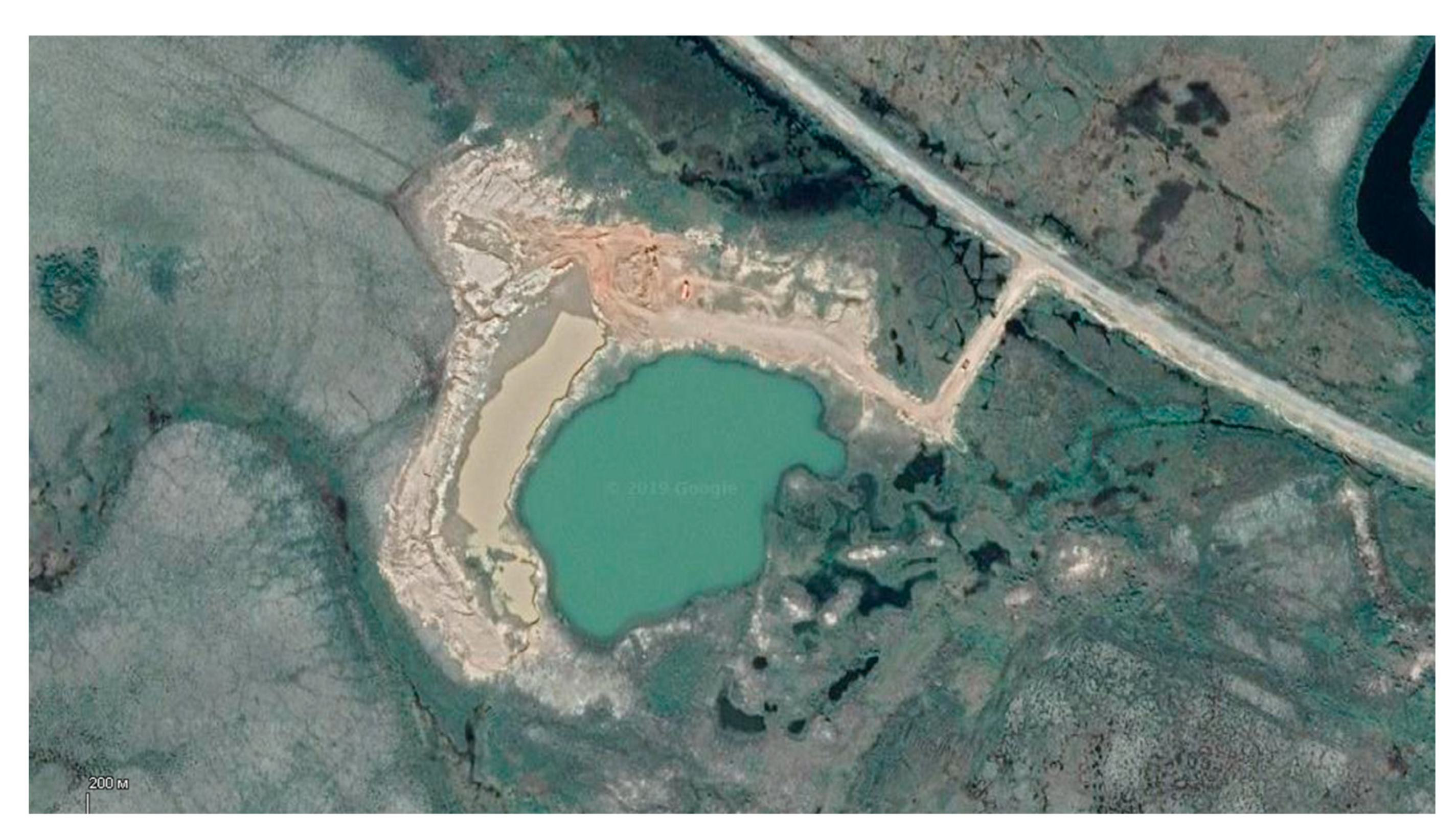
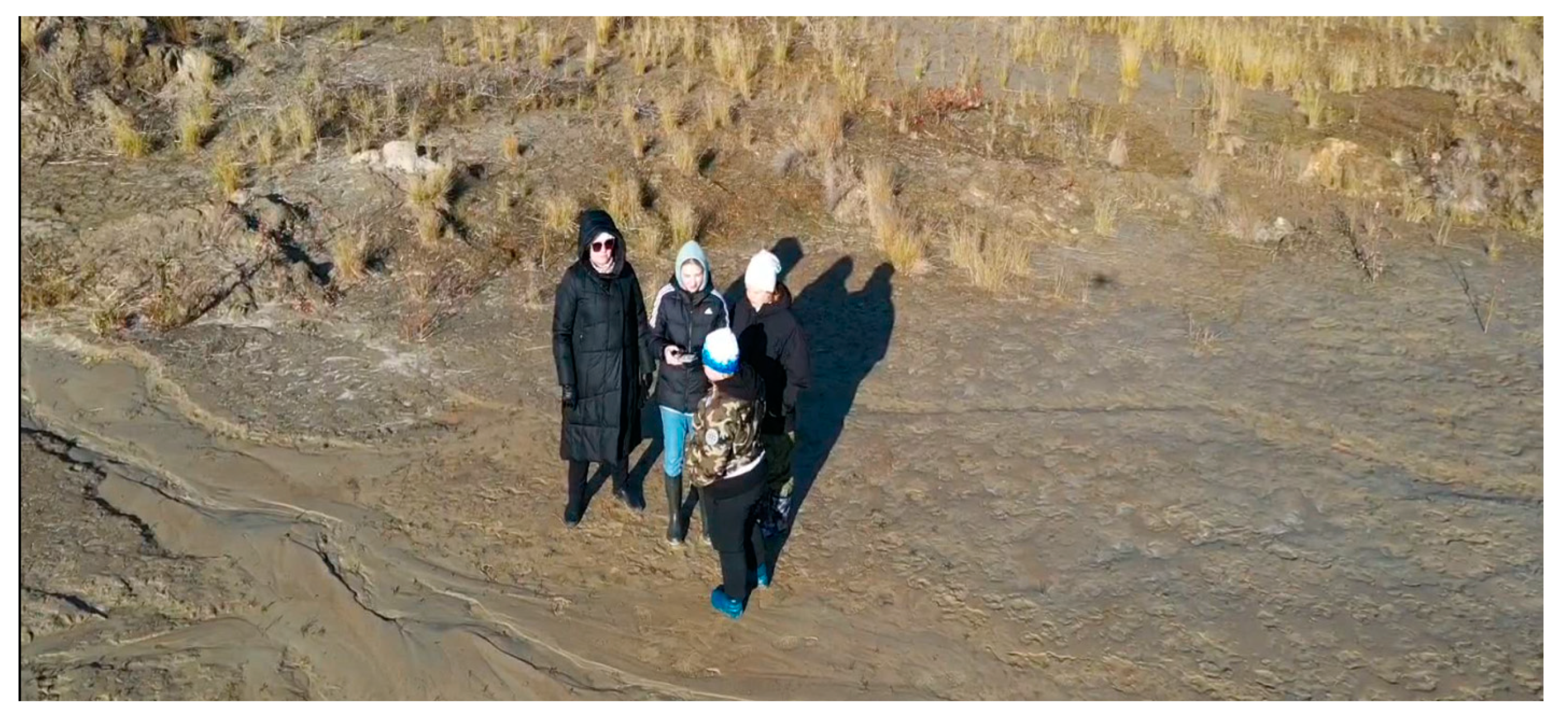

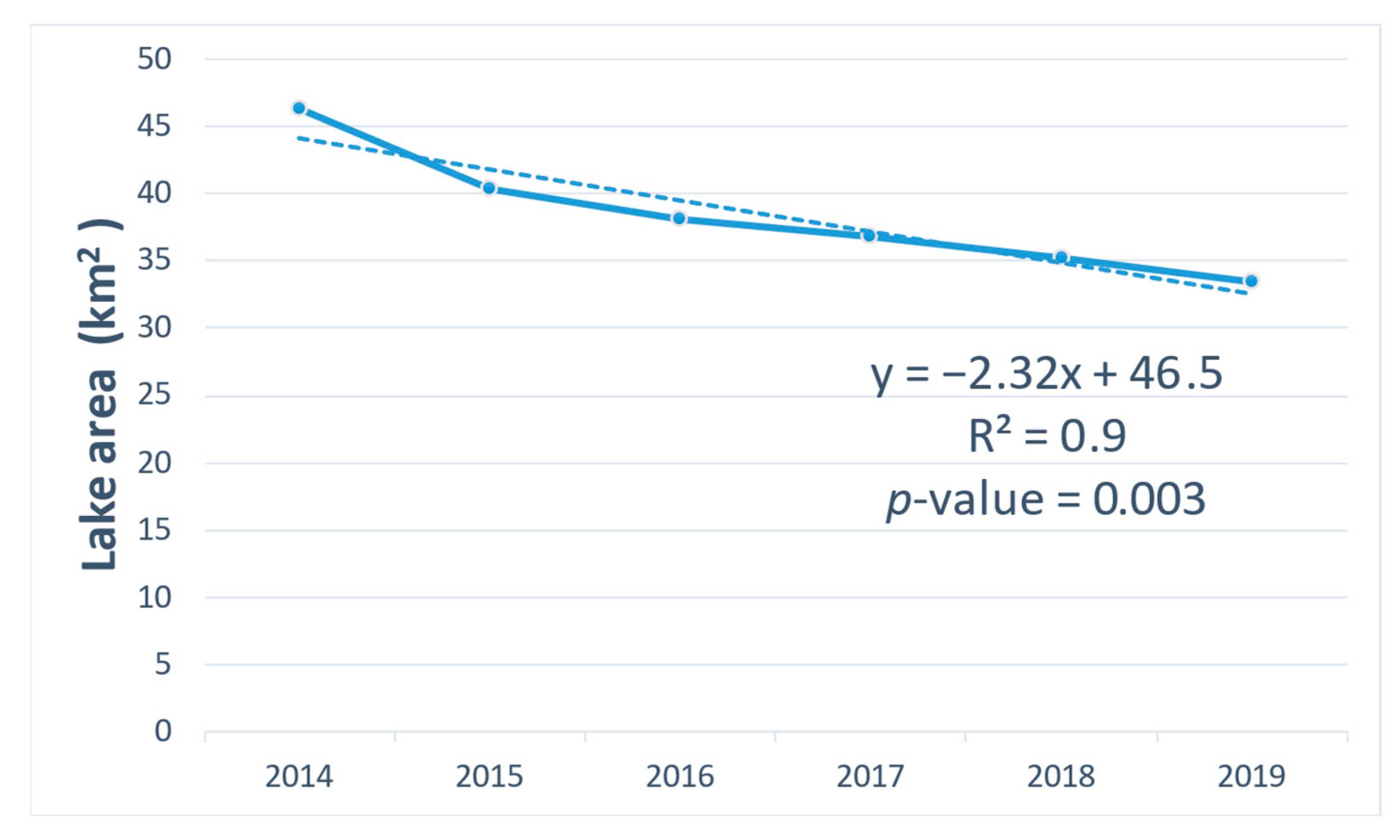
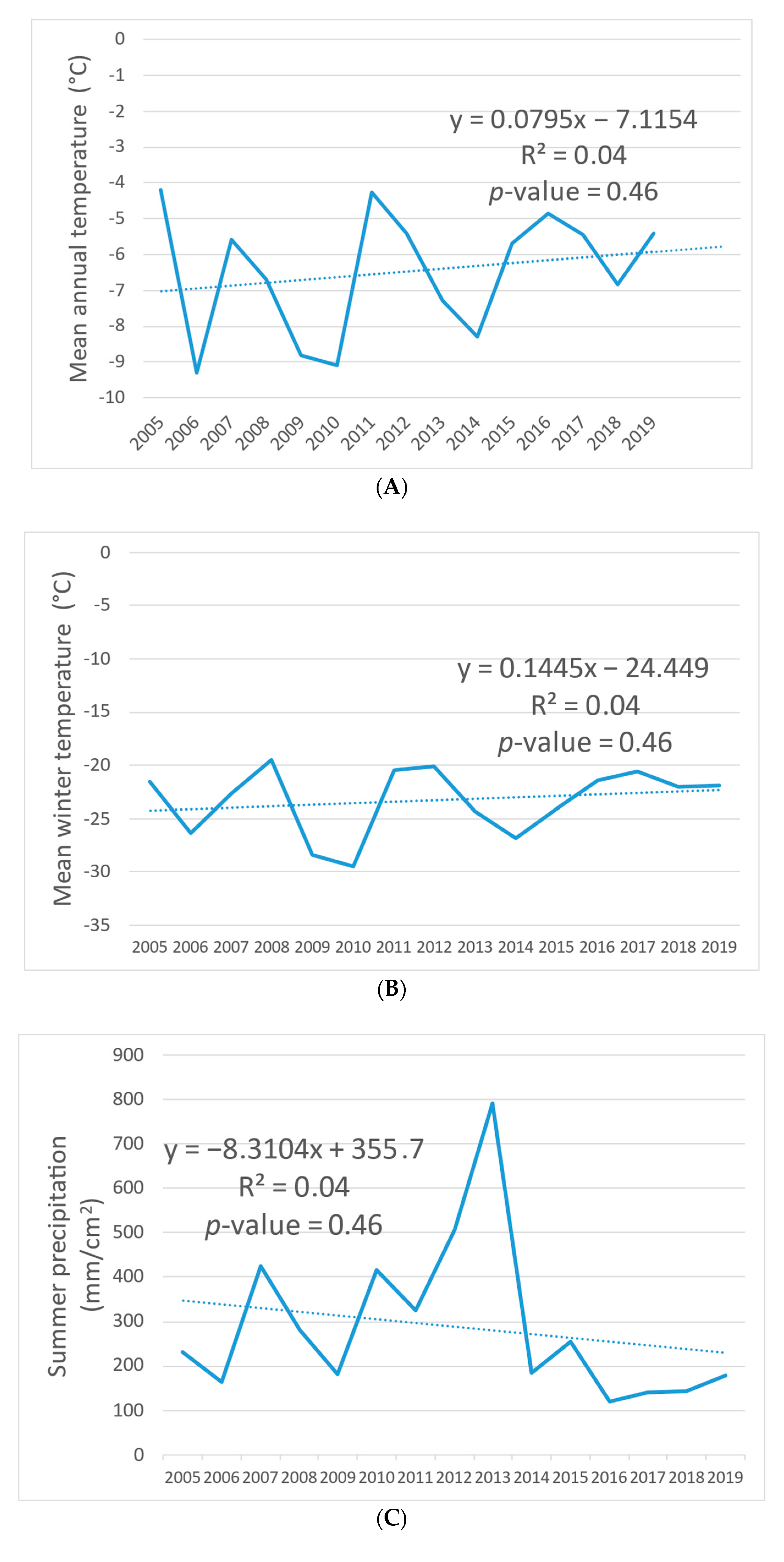
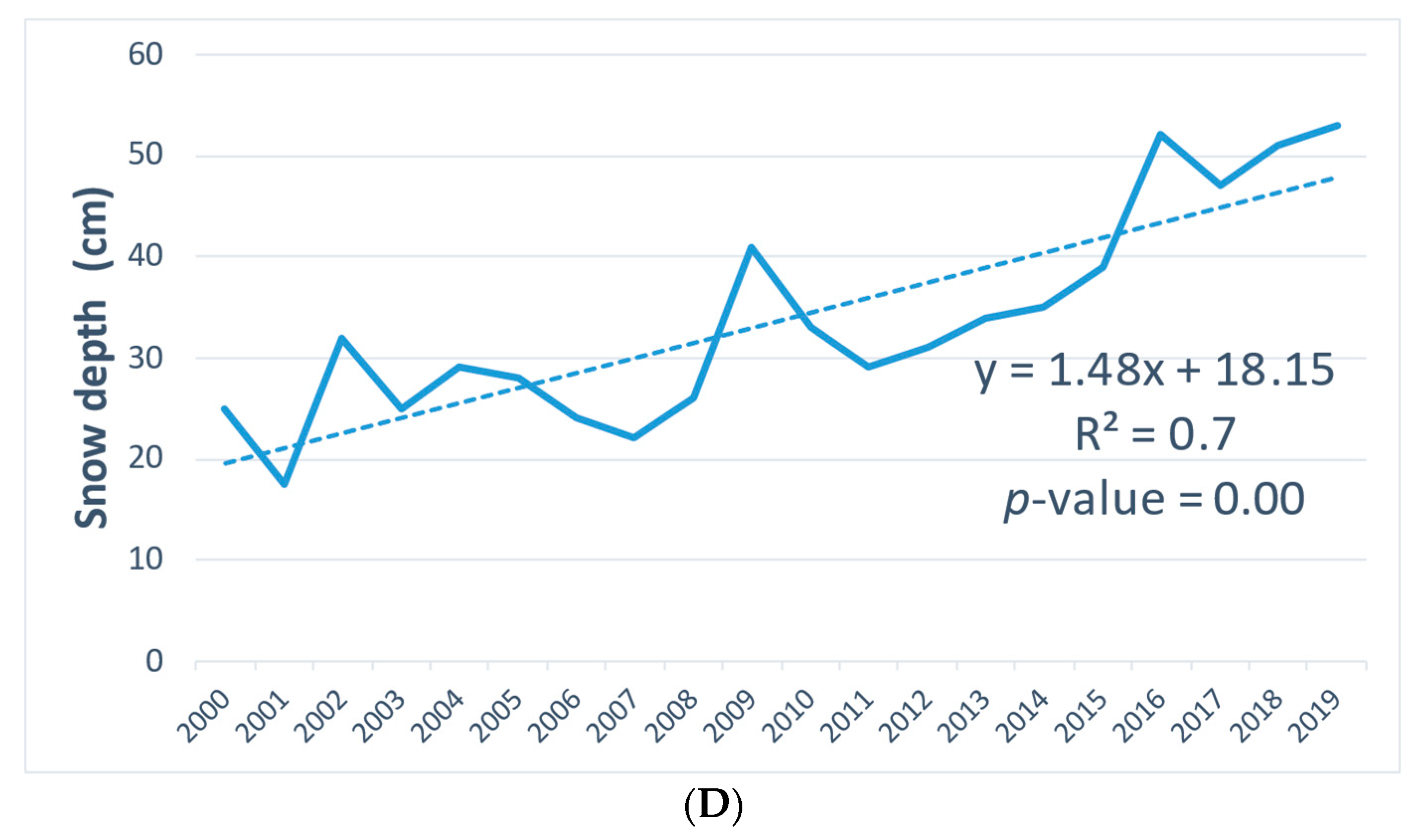


| Lakes | Maximum Diameter, m | Minimum Diameter, m | Lake Area, km2 | ||||
|---|---|---|---|---|---|---|---|
| 2014 | 2019 | 2014 | 2019 | 2014 | 2019 | Difference % | |
| Lake UA1 | 197 | 0 | 103 | 0 | 0.070 | 0 | −100 |
| Lake UA2 | 582 | 486 | 254 | 233 | 0.137 | 0.101 | −26.3 |
| Lake UA3 | 368 | 321 | 199 | 151 | 0.063 | 0.053 | −5.87 |
| Lake UA4 | 623 | 596 | 441 | 391 | 0.222 | 0.191 | −14.0 |
| Lake UA5 | 2865 | 2313 | 1251 | 936 | 3.324 | 2.071 | −37.7 |
| Lake UA6 | 2638 | 2145 | 1403 | 1224 | 3.204 | 2.227 | −30.5 |
| Lake UA7 | 486 | 458 | 432 | 362 | 0.165 | 0.131 | −20.6 |
| Lake UA8 | 498 | 412 | 385 | 343 | 0.153 | 0.114 | −25.5 |
| Lake UA9 | 345 | 339 | 289 | 261 | 0.079 | 0.070 | −23.9 |
| Mean | 955.8 | 785.6 | 528.6 | 433.4 | 0.821 | 0.551 | −31.6 |
| Standard error | 0.462 | 0.302 | |||||
| Lakes | Maximum Diameter, m | Minimum Diameter, m | Lake Area, km2 | ||||
|---|---|---|---|---|---|---|---|
| 2014 | 2019 | 2014 | 2019 | 2014 | 2019 | Difference % | |
| Lake UB1 | 286 | 268 | 168 | 153 | 0.040 | 0.035 | −12.5 |
| Lake UB2 | 265 | 248 | 172 | 159 | 0.037 | 0.032 | −13.5 |
| Lake UB3 | 462 | 417 | 298 | 246 | 0.113 | 0.086 | −23.9 |
| Lake UB4 | 312 | 271 | 252 | 241 | 0.062 | 0.051 | −17.7 |
| Lake UB5 | 452 | 385 | 287 | 271 | 0.107 | 0.084 | −21.5 |
| Lake UB6 | 685 | 649 | 452 | 436 | 0.253 | 0.231 | −8.7 |
| Lake UB7 | 648 | 612 | 447 | 421 | 0.235 | 0.209 | −11.1 |
| Lake UB8 | 928 | 895 | 536 | 502 | 0.420 | 0.383 | −8.8 |
| Lake UB9 | 323 | 318 | 203 | 172 | 0.054 | 0.047 | −13.0 |
| Mean | 484.6 | 451.4 | 312.8 | 289.0 | 0.15 | 0.12 | −12.3 ± SE |
| Standard error | 0.043 | 0.04 | |||||
| (A) | |||||
|---|---|---|---|---|---|
| Active Layer Thickness (cm) | Summer Precipitation (mm/cm2) | Mean Annual Temperature (°C) | Mean Winter Temperature (°C) | Mean Snow Depth (cm) | |
| Active layer thickness (cm) | 1 | ||||
| Summer precipitation (mm/cm2) | 0.521 | 1 | |||
| Mean annual temperature (°C) | 0.023 | −0.170 | 1 | ||
| Mean winter temperature (°C) | 0.008 | −0.570 | 0.806 | 1 | |
| Mean snow depth (cm) | −0.143 | −0.646 | −0.644 | 0.860 | 1 |
| (B) | |||||
| Summer precipitation (mm/cm2) | Mean annual temperature (°C) | Mean winter temperature (°C) | Mean snow depth (cm) | ||
| p-value for active layer thickness correlation with four climate variables | 0.289 | 0.988 | 0.955 | 0.787 | |
| (C) | |||||
| Summer precipitation (mm/cm2) | Mean annual temperature (°C) | Mean winter temperature (°C) | Mean snow depth (cm) | ||
| p-value for lake area correlation with four climate variables | 0.487 | 0.153 | 0.025 | 0.0125 | |
Disclaimer/Publisher’s Note: The statements, opinions and data contained in all publications are solely those of the individual author(s) and contributor(s) and not of MDPI and/or the editor(s). MDPI and/or the editor(s) disclaim responsibility for any injury to people or property resulting from any ideas, methods, instructions or products referred to in the content. |
© 2023 by the authors. Licensee MDPI, Basel, Switzerland. This article is an open access article distributed under the terms and conditions of the Creative Commons Attribution (CC BY) license (https://creativecommons.org/licenses/by/4.0/).
Share and Cite
Kunin, S.; Semenova, O.; Callaghan, T.V.; Shaduyko, O.; Bodur, V. Recording Permafrost Thaw and Thaw Lake Degradation in Northern Siberia: School Science in Action. Water 2023, 15, 818. https://doi.org/10.3390/w15040818
Kunin S, Semenova O, Callaghan TV, Shaduyko O, Bodur V. Recording Permafrost Thaw and Thaw Lake Degradation in Northern Siberia: School Science in Action. Water. 2023; 15(4):818. https://doi.org/10.3390/w15040818
Chicago/Turabian StyleKunin, Sergey, Olga Semenova, Terry V. Callaghan, Olga Shaduyko, and Vladimir Bodur. 2023. "Recording Permafrost Thaw and Thaw Lake Degradation in Northern Siberia: School Science in Action" Water 15, no. 4: 818. https://doi.org/10.3390/w15040818
APA StyleKunin, S., Semenova, O., Callaghan, T. V., Shaduyko, O., & Bodur, V. (2023). Recording Permafrost Thaw and Thaw Lake Degradation in Northern Siberia: School Science in Action. Water, 15(4), 818. https://doi.org/10.3390/w15040818







